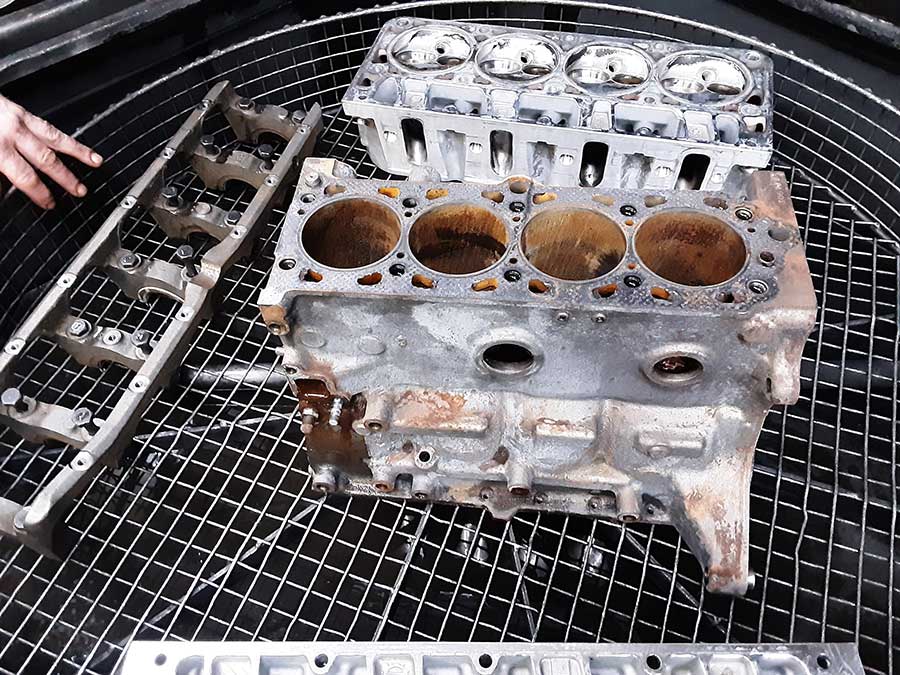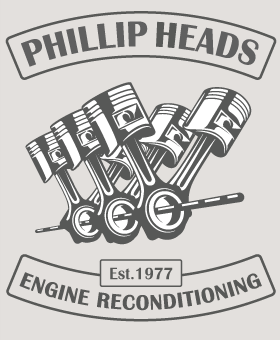Chemical Cleaning & Bead Blasting
Both chemical cleaning and bead blasting are effective methods for restoring engines, but they are best used for different purposes.
By performing engine chemical cleaning and bead blasting, you can ensure your engine is clean and free of contaminants, which will help it perform better and last longer. Both methods are essential for removing contaminants and restoring engine components to their original condition.
It is important to note that a professional engine builder or mechanic should do both chemical cleaning and bead blasting. The process can be dangerous if not done correctly and can cause damage to engine components if not done carefully. Phillip Heads have the necessary experience and equipment to perform these cleaning methods safely and effectively.
Chemical Cleaning
Chemical cleaning is ideal for removing contaminants from hard-to-reach areas, such as the inside of engine blocks or cylinder heads. It is also ideal for removing rust and corrosion built up over time.
Chemical cleaning of engine blocks and cylinder heads is crucial in engine rebuilding and repair. Over time, these engine components accumulate dirt, grime, and other contaminants, which can cause significant damage if not cleaned properly. Chemical cleaning helps remove these contaminants and ensure that the engine operates at its best.
Several chemical cleaning methods can be used to clean engine blocks and cylinder heads. The most common method is using a chemical cleaner specifically designed to dissolve and remove contaminants from engine components. This type of cleaner is typically applied to the engine components and allowed to sit for a specific time before being rinsed away with water.
Another method of chemical cleaning is the use of an ultrasonic cleaner. This type of cleaner uses high-frequency sound waves to agitate the cleaning solution, allowing it to penetrate and remove contaminants from hard-to-reach areas of the engine block and cylinder head.
Chemical cleaning of engine blocks and cylinder heads is an important process for several reasons:
- It helps to remove contaminants that can cause damage to engine components over time.
- It helps to ensure that the engine is operating at peak performance by removing any buildup or residue hindering the engine’s performance.
- It can help extend the engine’s life.
The type of cleaner used will depend on the specific contaminants that need to be removed and the type of engine component being cleaned. When performing chemical cleaning, it is essential to use the correct techniques to ensure the engine is cleaned safely and effectively.

Bead Blasting
Bead blasting is more effective at removing surface contaminants from engine components, such as the exterior of engine blocks, cylinder heads, and other engine parts. It is also effective at removing paint or other coatings that need to be removed before engine rebuilding or other repairs.
Bead blasting is a common technique for cleaning and restoring engine blocks, cylinder heads, and other engine components. This process involves using tiny glass, or ceramic beads blasted at high pressure onto the surface of the engine components. The beads remove dirt, grime, rust, and other contaminants, leaving a clean and smooth surface behind.
One of the main advantages of bead blasting is that it is a non-destructive process that does not damage the surface of the engine components. This makes it an ideal cleaning technique for delicate engine parts that require gentle cleaning, such as cylinder heads, intake manifolds, and carburettors. Bead blasting can also be used on engine blocks, crankshafts, and other significant engine components.
Bead blasting is a relatively simple process that involves the use of specialized equipment. The engine component is placed inside a blast cabinet, and the glass or ceramic beads are blasted at high pressure onto the component’s surface. The beads remove contaminants from the component’s surface, leaving a clean and smooth surface behind. After the blasting, the engine component is removed from the blast cabinet and cleaned to remove any remaining beads or debris.
Bead blasting is particularly useful for restoring vintage or classic cars, as it can remove decades of grime and rust from engine components. Bead blasting can also be used to prepare engine components for painting or other finishing techniques, as it creates a clean and smooth surface ready for painting or other finishing techniques.
One of the main disadvantages of bead blasting is that it can be time-consuming, particularly for large engine components.
Bead blasting is a highly effective technique for cleaning and restoring engine components and can be used on various engine components, including engine blocks, cylinder heads, and intake manifolds. Bead blasting is a non-destructive process that leaves a clean and smooth surface behind.

